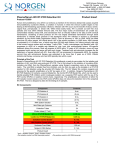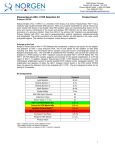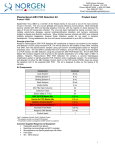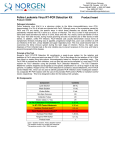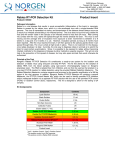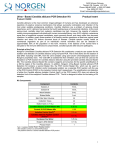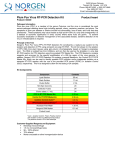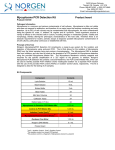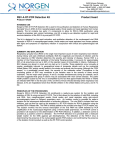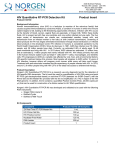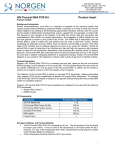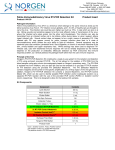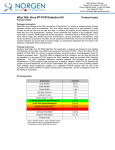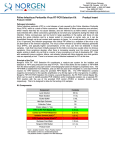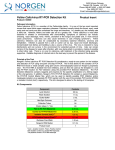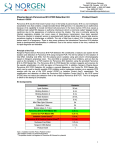Download Plasma-Serum HCV RT-PCR Detection Kit
Transcript
3430 Schmon Parkway Thorold, ON, Canada L2V 4Y6 Phone: 866-667-4362 (905) 227-8848 Fax: (905) 227-1061 Email: [email protected] Plasma/Serum HCV RT-PCR Detection Kit Product Insert Product # 37700 Hepatitis C virus infection is a major cause of chronic hepatitis, liver cirrhosis, and hepatocellular carcinoma (HCC) worldwide. Neither a vaccine nor an effective treatment is available for HCV. Pegylated interferon-α (PEG-IFN- α), combined with ribavirin, is the current standard therapy. Its efficiency ranges between 20-80%, depending on the HCV genotype. Unfortunately, many HCV infected patients do not respond to or do not tolerate the IFN-based therapy. Therefore, the number of patients progressing to HCC as a result of HCV infection is expected to increase over the next 20-30 years. The natural history of the disease reveals the elusive nature of the virus in a number of features. First, the infection is often detected incidentally at the time of blood donation as the acute infection is clinically asymptomatic in most patients. Second, HCV successfully escapes multi-specific host immune responses in the majority of patients which establishes persistent infection. Third, a significant number of persistently infected individuals remain unaware of the infection for decades, until liver fibrosis, cirrhosis and/or hepatocellular carcinoma develop. Principle of the Test Norgen’s Plasma/Serum HCV RT-PCR Detection Kit constituents a ready-to-use system for the isolation and detection of HCV viral RNA using end-point RT-PCR. The kit first allows for the isolation of circulating RNA, including viral RNA, from the plasma/serum samples using Norgen’s proprietary resin as the separation matrix. The viral RNA is isolated free from inhibitors, and can then be used as the template in a RT-PCR reaction for HCV detection using the provided HCV Master Mix. The HCV Master Mix contains reagents and enzymes for the specific amplification of a 380 bp region of HCV. In addition, Norgen’s Plasma/Serum HCV RT-PCR Detection Kit contains a second Mastermix, the Control RT-PCR Master Mix, which can be used to identify possible PCR inhibition and/or inadequate isolation via a separate PCR reaction with the use of the PCR control (PCRC) or Isolation Control (IsoC). The amplification and detection of either the HCV Isolation Control (IsoC) or the PCR control (PCRC) does not reduce the detection limit of the analytical HCV PCR. The kit is designed to allow for the testing of 24 samples. Kit Components: Component Contents PS Solution A 6 mL PS Solution B 45 mL PS Solution C 9 mL Wash Solution 22 mL RNA Elution Solution 3 mL Mini Filter Spin Columns 24 Collection Tubes 24 Elution tubes (1.7 mL) 24 HCV 2x RT-PCR Master Mix 0..35 mL Control 2x RT-PCR Mastermix 0.35 mL a 0.3 mL Isolation Control (IsoC) b HCV Positive Control (PosC) 0.1 mL Nuclease Free-Water 1.25 mL Norgen’s DNA Marker 0.1 mL Product Insert * IsoC = Isolation Control ; PosC= Positive Control a b 1 The isolation control is a RNA transcript product. The positive control is HCV RNA transcript 1 Customer-Supplied Reagents and Equipment Centrifuge with a swinging bucket rotor capable of 2000 RPM Benchtop microcentrifuge Micropipettors 96 – 100% ethanol β - Mercaptoethanol 15 mL tubes Disposable Latex gloves Micropipettes with an accuracy range between 1-10 µL, 10-100 µL and 100-1000 µL Laminar flow hood for extractions Vortex Sterile, nuclease-free aerosol-barrier micropipettor tips Microcentrifuge tube rack PCR tubes Storage Conditions and Product Stability All buffers should be kept tightly sealed and stored at room temperature (15-25oC) for up to 1 year without showing any reduction in performance. It is recommended to warm PS Solution A, PS Solution B and PS Solution C for 20 minutes at 60oC if any salt precipitation is observed. The Positive Control (HCV PosC, red cap) and Isolation Control (IsoC, orange cap) should be stored at -70°C. If needed, make aliquots of the controls according to the volume used in the protocol (10 L of HCV PosC or 15 L of IsoC) prior to freezing. The HCV 2X RT-PCR Mastermix and the Control 2X RT-PCR Mastermix should be stored at -20°C. Make appropriate aliquots if needed All other kit components may be stored at room temperature The HCV 2X RT-PCR Mastermix, the Control 2X RT-PCR Mastermix, HCV Postive Control (PosC) and the Isolation Control (IsoC) should not undergo repeated freeze-thaw (a maximum freeze-thaw of three times). Allow reagents to thaw at room temperature prior to use After addition of samples to RT-PCR Master Mix use within one hour Kit reagents are stable through the end of the expiration month indicated on the packaging label when stored at the recommended temperatures. General Precautions Follow universal precautions. All patient specimens should be considered as potentially infectious and handled accordingly. Diagnostic laboratory work on clinical samples from patients who are suspected of having HCV infection should be conducted in a BSL2 laboratory. All sample manipulations should be carried out in a biosafety cabinet. Viral isolation on clinical specimens from patients who are suspected of having HCV infection should be performed in a BSL2 laboratory with BSL3 practices Wear personal protective equipment, including gloves and lab coats when handling kit reagents. Wash hands thoroughly when finished performing the test. Do not smoke, drink or eat in areas where kit reagents and/or human specimens are being used. Dispose of unused kit reagents and human specimens according to local, provincial or federal regulations. Workflow in the laboratory should proceed in a uni-directional manner, beginning in the preamplification area(s) (i.e. specimen collection and RNA extraction) and moving to the amplification / detection area(s) (RT-PCR and gel electrophoresis). Do not use supplies and equipment across the dedicated areas of specimen extraction and sample preparation. No cross-movement should be allowed between the different areas. Supplies and equipment used for specimen preparation should not be used for pipetting or processing amplified RNA or other sources of target nucleic acids. All amplification supplies and equipment should be kept in the amplification / detection area at all times. 2 Personal protective equipment, such as laboratory coats and disposable gloves, should be area specific. As contamination of patient specimens or reagents can produce erroneous results, it is essential to use aseptic techniques. Pipette and handle reagents carefully to avoid mixing of the samples. Use proper pipetting techniques and maintain the same pipetting pattern throughout the procedure to ensure optimal and reproducible values. Do not substitute or mix reagents from different kit lots or from other manufacturers. Do not interchange reagent tube / bottle caps as this may lead to contamination and compromise test results. Only use the protocol provided in this insert. Alterations to the protocol and deviations from the times and temperatures specified may lead to erroneous results. Quality Control In accordance with Norgen’s ISO 9001 and ISO 13485-certified Quality Management System, each lot of Norgen’s HCV 2x RT-PCR Master Mix, Control 2X RT-PCR Mastermix, Isolation Control (IsoC) and and the HCV Positive Control (PosC) are tested against predetermined specifications to ensure consistent product quality. Product Use Limitations Norgen’s Plasma/Serum HCV RT-PCR Detection Kit is designed for research purposes only. Product Warranty and Satisfaction Guarantee NORGEN BIOTEK CORPORATION guarantees the performance of all products in the manner described in our product manual. The customer must determine the suitability of the product for its particular use. Safety Information Biosafety level 2 practices are recommended for works involving clinical samples from patients who are suspected of having HCV infection. Ensure the appropriate containment equipment and facilities are used for activities involving cultures or potentially infectious clinical materials. Ensure that a suitable lab coat, disposable gloves and protective goggles are worn when working with chemicals. For more information, please consult the appropriate Material Safety Data Sheets (MSDSs). These are available as convenient PDF files online at www.norgenbiotek.com. CAUTION: DO NOT add bleach or acidic solutions directly to the sample-preparation waste. PS Solution A, PS Solution B and PS Solution C contain guanidinium salts, and should be handled with care. Guanidinium salts form highly reactive compounds when combined with bleach, thus care must be taken to properly dispose of any of these solutions If liquid containing these buffers is spilt, clean with suitable laboratory detergent and water. If the spilt liquid contains potentially infectious agents, clean the affected area first with laboratory detergent and water, and then with 1% (v/v) sodium hypochlorite. Plasma or serum of all human and animal subjects is considered potentially infectious. All necessary precautions recommended by the appropriate authorities in the country of use should be taken when working with plasma or serum 3 Protocol A. Specimen Collection, Storage and Transport Precaution: All samples must be treated as potentially infectious material. 1. Specimen Collection and Sample Storage Blood withdrawal causes injury of blood vessels (arteries, veins and capillaries). Only safe and sterile material should be used. For blood withdrawal appropriate disposables are available. For the vein puncture, too fine capillary needles should not be employed. Venous blood withdrawal should be carried out on the appropriate parts of the elbow bend, the forearm or the back of the hand. Blood has to be withdrawn with standard specimen collection tubes (red cap, Sarstedt or equivalent tube of another manufacturer). 5 - 10 ml EDTA blood should be withdrawn. Precaution: Samples of heparinised humans must not be used 2. Sample Storage Whole blood should be separated into plasma and cellular components by centrifugation for 20 minutes at 800 - 1,600 x g within six hours. The isolated plasma has to be transferred into sterile polypropylene tubes. The sensitivity of the assay can be reduced if you freeze the samples as a matter of routine or store them for a longer period of time. Virus encapsulated RNA is stable for weeks if stored at -20°C and even for months and years when stored at -70°C. 3. Sample Transport Sample material should be transported in a shatterproof, leak-proof transport container as a matter of principle. Thus, a potential danger of infection due to a leakage of sample can be avoided. The samples should be transported following the local and national instructions for the transport of pathogen material. We recommend sample transport with a courier. The blood samples should be shipped cooled (+2°C to +8°C) and the separated plasma deep frozen (-20°C). 4. Interfering substances Elevated levels of bilirubin (15 mg/dl) and lipids (800 mg/dl) and haemolytic samples do not influence the system. Heparin (10 IU/ml) affects the PCR. Samples which have been collected in tubes containing heparin as an anticoagulant should not to be used. Also, samples of heparinised patients must not be used. B. Purification of HCV RNA from 2mL Serum or Plasma Working with RNA RNases are very stable and robust enzymes that degrade RNA. Autoclaving solutions and glassware is not always sufficient to actively remove these enzymes. The first step when preparing to work with RNA is to create an RNase-free environment. The following precautions are recommended as your best defence against these enzymes. The RNA area should be located away from microbiological work stations Clean, disposable gloves should be worn at all times when handling reagents, samples, pipettes, disposable tubes, etc. It is recommended that gloves are changed frequently to avoid contamination There should be designated solutions, tips, tubes, lab coats, pipettes, etc. for RNA only 4 All RNA solutions should be prepared using at least 0.05% DEPC-treated autoclaved water or molecular biology grade nuclease-free water Clean all surfaces with commercially available RNase decontamination solutions When working with purified RNA samples, ensure that they remain on ice during downstream applications Notes Prior to Use All centrifugation steps are performed at room temperature. A variable speed centrifuge should be used for maximum kit performance. If a variable speed centrifuge is not available a fixed speed centrifuge can be used, however reduced yields may be observed. Ensure that all solutions are at room temperature prior to use. Prepare a working concentration of the Wash Solution by adding 50 mL of 96 - 100% ethanol (provided by the user) to the supplied bottle containing the concentrated RNA Wash Solution. This will give a final volume of 72 mL. The label on the bottle has a box that may be checked to indicate that the ethanol has been added. The use of β-mercaptoethanol in lysis is highly recommended to isolate RNA for sensitive downstream applications. Add 10 µL of β-mercaptoethanol (provided by the user) to each 1 mL of PS Solution B.. PS Solution A contains resin and must be mixed well before every pipetting. It is highly recommended to warm up PS Solution A, PS Solution B and PS Solution C at 60oC for 20 minutes and mix well until the solutions become clear again if precipitates are present. It is important to work quickly during this procedure. This kit is suitable for the isolation of Viral RNA from serum or plasma prepared from blood collected on either EDTA or citrate. Plasma samples prepared from blood collected on heparin should not be used as heparin can significantly interfere with many downstream applications such as RT-PCR. It is important to work quickly during this procedure. An Isolation Control (IsoC) is supplied. This allows the user to control the viral RNA isolation procedure. For this assay, add the Isolation Control (IsoC) to the lysate during the isolation procedure. o The Isolation Control (IsoC) must not be added to the sample material directly o Do not freeze and thaw the Isolation Control (IsoC) more than 3 times. o The Isolation Control (IsoC) must be kept on ice at all times during the isolation procedure. 1. In a 50 mL tube (provided by the user), add 0.2 mL of PS Solution A and 1.8 mL PS Solution B (after the addition of β-mercaptoethanol) to 1 mL plasma/serum sample. Mix well by vortexing for 15 seconds. (Note: PS Solution A contains resin and must be mixed well before every pipeting) 2. Incubate the mixture from Step 1 for 10 minutes at 60oC. 3. After incubation add 3 mL of 96-100% ethanol (provided by the user). Mix well by vortexing for 15 seconds. 4. Centrifuge for 30 seconds at 1,000 RPM, then carefully decant the supernatant in order to ensure that the slurry pellet is not dislodged. 5. To the slurry pellet add 0.3 mL PS Solution C, and mix well by vortexing for 15 seconds. 6. Incubate the mixture from Step 5 for 10 minutes at 60oC. 7. After incubation add 0.3 mL 96-100% ethanol (provided by the user) then add 10 μL of Isolation Control (IsoC) to the lysate mixture. Mix well by vortexing for 15 seconds. 8. Transfer 650 L from the mixture from Step 7 into a Mini Filter Spin column. Centrifuge for 1 minute at 14,000 RPM. Discard the flowthrough and reassemble the spin column with its collection tube. 9. Repeat Step 8 until all the mixture from Step 7 has been transferred to the Mini Filter Spin column. 10. Apply 400 µL of Wash Solution to the column and centrifuge for 1 minute at 14,000 RPM. Discard the flowthrough and reassemble the spin column with its collection tube. 11. Repeat step 10 two more times, for a total of three washes. 12. Spin the column, empty, for 3 minutes at 14,000 RPM. Discard the collection tube. 5 Transfer the spin column to a fresh 1.7 mL Elution tube. Apply 100 L of Elution solution to the column and centrifuge for 2 minutes at 2,000 RPM, followed by 3 minute at 14,000 RPM. C. HCV RT-PCR Assay Preparation Notes: Before use, suitable amounts of all RT-PCR components should be completely thawed at room temperature, gently vortexed and centrifuged briefly. The amount of HCV 2X RT-PCR Master Mix provided is enough for up to 32 RT-PCR reactions (24 sample RT-PCR, 4 positive control RT-PCR and 4 no template control RT-PCR). For each sample, one RT-PCR reaction using the HCV 2X RT-PCR Mastermix and one RTPCR reaction using Control 2X RT-PCR Mastermix should be set up in order to have a proper interpretation of the results. For every RT-PCR run, one reaction containing HCV Positive Control (HCV PosC) and one reaction as no template control (Nuclease Free-Water) must be included for proper interpretation of results. The recommended minimum number of RNA samples tested per RT-PCR run is 6. Using a lower volume from the sample than recommended may affect the sensitivity of HCV Limit of Detection. 1. Prepare the RT-PCR reaction for sample detection (Set #1, using HCV 2X Detection RT-PCR Mastermix) and the RT-PCR reaction for control detection (Set #2, using Control 2X RT-PCR Mastermix) as shown in Table 1 below. The recommended amount of sample RNA to be used is 1 - 2 µL. Ensure that one HCV detection reaction and one control reaction is prepared for each RNA sample. Adjust the final volume of the RT-PCR reaction to 20 µL using the Nuclease-Free Water provided. Table 1. RT-PCR Assay Preparation RT-PCR Components Volume Per RT-PCR Reaction HCV 2X RT-PCR Master Mix Or Control 2X RT-PCR Master Mix 10 µL Sample RNA 2 µL Nuclease-Free Water 8 µL Total Volume 20 µL 2. For every RT-PCR run, prepare one positive control RT-PCR as shown in Table 2 below: Table 2. RT-PCR Positive Control Preparation RT-PCR Components Volume Per RT- PCR Reaction HCV 2X RT-PCR Master Mix Or Control 2X RT-PCR Master Mix 10 µL HCV Positive Control (PosC) 10 µL Total Volume 20 µL 6 3. For every RT- PCR run, prepare one no template control RT-PCR as shown in Table 3 below: Table 3. RT-PCR Negative Control Preparation RT-PCR Components Volume Per RT-PCR Reaction HCV 2X RT- PCR Master Mix Or Control 2X RT-PCR Master Mix 10 µL Nuclease-Free Water 10 µL Total Volume 20 µL Therefore, at a minimum, each PCR run will contain 6 separate RT-PCR reactions. D. HCV One Step RT-PCR Assay Programming 1. Program the thermocylcer according to the program shown in Table 4 below. 2. Run one step RT-PCR. Table 4. HCV Assay Program One Step RT-PCR Cycle Step Temperature Duration Cycle 1 Step 1 50oC 30 min Cycle 2 Cycle 3 (40x) o Step 1 95 C 3 min Step 1 94oC 15 sec o Step 2 60 C 30 sec Step 3 72oC 45 sec o Cycle 4 Step 1 72 C 5 min Cycle 5 Step 1 4oC ∞ E. HCV One Step RT-PCR Assay Results Interpretation 1. For the analysis of the RT-PCR data, the entire 20 µL RT-PCR Reaction should be loaded on a 1X TAE 1.5% Agarose RNA gel along with 10 L of Norgen’s RNA Marker (provided). 2. The RT-PCR products should be resolved on the 1X TAE 1.5% Agarose gel at 150V for 20 minutes (Gel running time will be vary depending on an electrophoresis apparatus). 3. Sample results are provided below 7 M NegC PosC 2000 1500 1000 750 500 300 150 50 Figure 1: A representative 1X TAE, 1.5% agarose gel showing the amplification of HCV at different concentrations (Target). The size of the HCV target amplicon corresponds to the 380 bp band represented by the provided DNA Marker (M). PosC lanes shows the positive HCV amplicon whereas NegC lanes shows the negative control. 1 2 3 4 5 6 7 8 M Isolation control PCR control Figure 2: A representative 1X TAE 1.5% agarose gel showing the amplification of Isolation Control and PCR Control under different conditions using the Control 2X RT-PCR Mastermix. The size of the Isolation Control amplicon and PCR Control amplicon correspond to 499 bp and 150 bp, respectively, as represented by the provided DNA Marker (M). Lanes 1 to 6 showed detection of both Isolation Control and PCR Control, suggesting that the RNA isolation as well as the RT-PCR reaction was successful. Lane 7 and 8 showed only the detection of PCR Control suggesting that while the RT-PCR was successful, the isolation failed to recover even the spiked-in Isolation control. 8 Table 5. Interpretation of One Step RT-PCR Assay Results Input Type Target reaction Control Reaction Interpretation HCV Target Band (297 bp) IsoC Band (499 bp) PCRC Band (150 bp) Positive Control Negative Control X X X X Valid Valid Sample X X X Positive X X Negative Sample Sample X Sample Re-test Re-test Sample X Sample X Sample X Sample X Negative X X Positive Positive Re-test ** For results obtained that are not covered in Table 5 above, please refer to the Troubleshooting Section. F. Specificity The specificity of Norgen’s Plasma/Serum HCV RT-PCR Detection Kit is first and foremost ensured by the selection of the HCV-specific primers, as well as the selection of stringent reaction conditions. The primers were checked for possible homologies in GenBank published sequences by sequence comparison analyses. Furthermore, the specificity of the HCV-specific primers were tested against most of the known sexually-transmitted pathogens. G. Linear Range The linear range of Norgen’s Plasma/Serum HCV RT-PCR Detection Kit was determined by 9 -1 analyzing a dilution series of HCV quantitative standards ranging from 8.46 x 10 VP/µl to 1 x 10 IU/µl. Each dilution has been tested in replicates (n = 4) using Norgen’s Plasma/Serum HCV RT-PCR Detection Kit on 1X TAE, 1.7% Agarose gels. The linear range of Norgen’s Plasma/Serum HCV RT-PCR Detection Kit has been determined to cover concentrations from 12 VP/µl to at least 8 x 106 VP/µl Under the conditions of Norgen’s Plasma/Serum circulating RNA Isolation procedure, Norgen’s Plasma/Serum HCV RT-PCR detection Kit covers a linear range from 200VP/mL Plasma/Serum to at least 8 x 109 VP/mL Plasma/Serum. H. Frequently Asked Questions 1. How many samples should be included per PCR run? Norgen’s Plasma/Serum HCV RT-PCR Detection Kit is designed to test 24 samples. For every 6 samples, a Negative Control and a Positive Control must be included. It is preferable to pool and test 6 samples at a time. If not, the provided Negative Control and Positive Control are enough to run 3 samples at a time. 2. How can I interpret my results for a sample if neither the HCV PCR control nor the HCV Isolation Control (IsoC) amplifies? If neither the HCV PCR control nor the HCV Isolation Control (IsoC) amplifies, the sample must be retested. If the positive control showed amplification, then the problem occurred during the isolation, where as if the Positive control did not amplify the problem has occurred during the setup of the PCR assay reaction. 9 3. How should it be interpreted if only the HCV PCR control showed amplification but neither the HCV target nor the HCV Isolation Control (IsoC) amplified for a sample? This indicates a poor isolation. The isolation procedure must be repeated. 4. How should it be interpreted if only the HCV Isolation Control (IsoC) was amplified in a sample? The sample tested can be considered as HCV negative. 5. How should it be interpreted if only the HCV target and the HCV PCR control were amplified in a sample? The sample tested can be considered as HCV positive. 6. How should it be interpreted if only the HCV target was amplified in a sample? The sample tested can be considered positive. At high HCV viral load, the HCV amplicon will be predominant and the HCV PCR control as well as the HCV Isolation control may not amplify. 7. How should it be interpreted if only the HCV PCR control and the HCV Isolation Control (IsoC) showed amplification? The sample tested can be considered negative 8. Can I process a different Plasma/Serum volume? The reagents provided with the isolation kit are only sufficient to process 24 Plasma/Serum samples of 2mL each. 9. What If I added more or less of the specified reagents’ volume during RNA isolation? Adding less volume may reduce your RNA yields. Adding more may not affect the RNA yields EXCEPT if more Elution Buffer was added. Eluting RNA in higher volumes of Elution Buffer will result in diluting your RNA. 10. What If I forgot to do a dry spin after my second wash? Your RNA elution will be contaminated with the Wash Solution. This may dilute the RNA yield in your elution and it may interfere with your down stream applications. 11. What If I forgot to add the HCV Isolation control during the Isolation? The Isolation must be repeated. Technical Assistance NORGEN’s Technical Service Department is staffed by experienced scientists with extensive practical and theoretical expertise in sample and assay technologies and the use of NORGEN products. If you have any questions or experience any difficulties regarding Norgen’s Plasma/Serum HCV PCR Detection Kit or NORGEN products in general, please do not hesitate to contact us. NORGEN customers are a valuable source of information regarding advanced or specialized uses of our products. This information is helpful to other scientists as well as to the researchers at NORGEN. We therefore encourage you to contact us if you have any suggestions about product performance or new applications and techniques. For technical assistance and more information, please contact our Technical Support Team between the hours of 8:30 and 5:30 (Eastern Standard Time) at (905) 227-8848 or Toll Free at 1-866-667-4362 or call one of the NORGEN local distributors (www.norgenbiotek.com) or through email at [email protected]. 3430 Schmon Parkway, Thorold, ON Canada L2V 4Y6 Phone: (905) 227-8848 Fax: (905) 227-1061 Toll Free in North America: 1-866-667-4362 ©2013 Norgen Biotek Corp. PI37700-4 10











